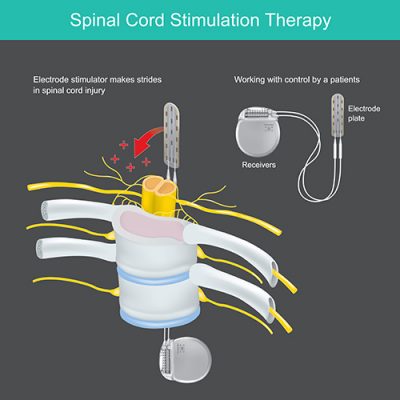 Chronic pain is a common and debilitating condition that can drastically reduce your quality of life. If you suffer from chronic pain, you may be searching for effective treatment options. Spinal cord stimulation (SCS) is a promising treatment that has been shown to be effective in reducing chronic pain.
Chronic pain is a common and debilitating condition that can drastically reduce your quality of life. If you suffer from chronic pain, you may be searching for effective treatment options. Spinal cord stimulation (SCS) is a promising treatment that has been shown to be effective in reducing chronic pain.
SCS is a minimally invasive procedure that involves placing electrical leads on the spinal cord. The treatment is typically delivered through a small device that is implanted under the skin. These leads deliver electrical pulses to the spinal cord, which modulate the pain signals that are sent to the brain. By implanting a spinal cord stimulator, Dr. Giron, Dr. DeLaPerriere, or Dr. Earls can significantly reduce the pain sensations you feel in a specific part of your body. SCS is a safe and effective treatment that has been used to treat chronic pain for over 50 years.
SCS has been shown to be effective in treating a variety of conditions, including failed back surgery syndrome, complex regional pain syndrome, and degenerative disc disease.
How Does a Spinal Cord Stimulator Work?
Neuromodulation works by blocking and changing pain signals from sensory nerves before they reach the brain and are perceived as pain. Once a spinal cord stimulator is implanted into the body, pain signals are blocked, so the patient no longer experiences the same level of suffering. Essentially, this device can turn down the pain’s “volume” so that it is no longer the focal point of your life. Neuromodulation is achieved with a minimally invasive, outpatient procedure that uses some of the newest and most advanced technology available.
What Does the Spinal Cord Stimulator Implantation Involve?
The trial implantation of a spinal cord stimulator involves undergoing a minor surgical procedure. After anesthetizing your skin, your doctor at the Pain Institute of Georgia inserts one or two insulated wire leads, threading them through an epidural needle or making a small incision in the epidural space to access your spinal nerves.
To ensure they place the leads in the most effective position, your doctor asks you to tell them when you feel the most noticeable reduction in pain. You wear an external unit for your trial period that you control with a remote device, turning the intensity up when you get a pain flare-up and down when it eases off.
If your spinal cord stimulation trial is a success, you can arrange to undergo the full implantation procedure. For this, you need another surgery to replace the temporary leads and implant the spinal cord stimulator generator, which goes under the skin of your buttocks or abdomen.
If your chronic pain isn’t improving with current treatments, spinal cord stimulation could provide the relief you seek. Find out more by calling the Pain Institute of Georgia at 478-476-9976.

